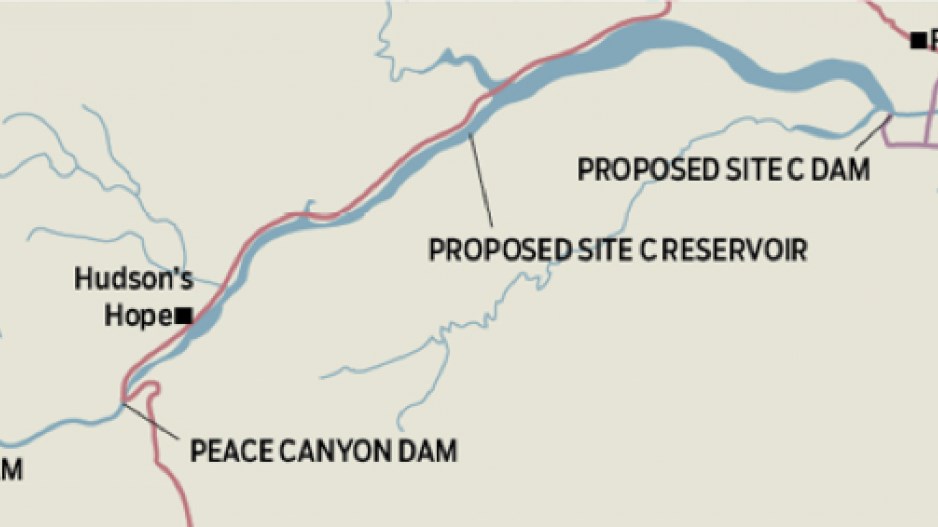Every time the B.C. government has built a hydroelectric dam on the Peace River, Hudson's Hope has experienced a boom that leaves behind a new hotel or bank and a handful of permanent jobs.
BC Hydro, which has two dams within District of Hudson's Hope, is the municipality's largest employer.
So it may seem surprising to some that Hudson's Hope doesn't want another dam on the Peace River.
It recently commissioned a review of BC Hydro's economic case for the proposed Site C dam and is lobbying the provincial government to consider other alternatives to generate power, including a $1 billion upgrade to the Burrard thermal power plant in Port Moody.
The Site C dam would take about eight years to build, at a cost of $7.9 billion, and at its peak would employ roughly 1,400 people per year over a two-year period, and about 800 per year over a four-year period.
The dam itself would be more than 80 kilometres away, just outside Fort St. John, so Hudson's Hope is not likely to see much in the way of permanent or temporary jobs. What it will see is the loss of thousands of hectares of land, along with the taxes they generate, to a new reservoir.
Hudson's Hope Mayor Gwen Johansson said the benefits of having a Crown corporation like BC Hydro as an anchor employer aren't all they're cracked up to be.
The W.A.C. Bennett and Peace Canyon hydroelectric dams are both within the District of Hudson's Hope. Roughly 80 BC Hydro workers live in Hudson's Hope, Johansson said, but what the town has gained in jobs, it has lost in taxes.
“There's pros and cons to having a Crown corporation as your main industry, because they don't pay taxes,” Johansson said.
“We don't get taxes on the assessed value of the dam because you can't collect taxes from Crown corporations on [power] generation.”
Johansson said Crown corporations, not municipalities, determine how much they should pay in grants in lieu of taxes, and in some cases it's literally pennies.
Johansson points to Lynx Creek as an example of what happens when a Crown corporation buys up property for major public infrastructure projects. The rural subdivision once had about 30 acreages, a fire hall, gas station and café. In the 1970s, BC Hydro began buying up land, and Lynx Creek slowly vanished, along with its tax base.
“So now … the district gets 13 cents in taxes for some of those lots,” Johansson said. “We've lost those taxes from the 1970s and continue to lose them. The same thing will be happening with the properties that they're buying now.”
The Site C dam's 83-kilometre reservoir would run from Hudson's Hope to Fort St. John and would require the flooding of more than 5,560 hectares of land, including 3,225 hectares of agricultural land, 591 hectares of which is farmland that is in production, according to BC Hydro.
The District of Hudson's Hope will lose 603 hectares of land to flooding and another 66 hectares for highway realignment. According to BC Hydro, a total of 120 land holdings will be affected along the reservoir. Thirty of them have homes, some of which will have to move.
According to BC Hydro community relations manager David Conway, Hudson's Hope receives $1.3 million a year in grants in lieu of taxes. He added BC Hydro offered a legacy benefit agreement to communities in the Peace River region of $2.4 million per year over 70 years.
It would be divided among the communities in the region, but Hudson's Hope may not receive any money because it has not signed the agreement. Several other regional directors have also refused to sign the agreement.
BC Hydro does not need to spend $7.9 billion on a new hydroelectric dam on the Peace River to generate new power, according to Hudson's Hope.
On July 9, the municipality released an economic analysis of the Site C dam conducted for the municipality by Urban Systems.
The community is concerned about the loss of farmland to flooding to create a reservoir. But it is also concerned about the costs of building Site C.
The report concludes BC Hydro does not need to spend $7.9 billion to get that amount of power. A less expensive alternative, it says, would be to upgrade the existing power plant at the W.A.C. Bennett dam and add a sixth turbine to the Revelstoke dam.
It also suggests not mothballing the Burrard thermal power plant, as BC Hydro plans to do in 2016, but rather spending $1 billion to upgrade it. The report also recommends that BC Hydro invest in solar and geothermal power.
But as BC Hydro community relations manager David Conway points out, in BC Hydro's last call for proposals in 2010, none of the bids it received was for solar or geothermal power.
He added that it's not just in B.C., where hydroelectric power from dams is considered the best bang for the public buck.
“Right now in North America, the lowest rates in North America are with Hydro-Québec, Manitoba Hydro, BC Hydro third, Seattle Power and Light – all have large hydro facilities,” Conway said.




